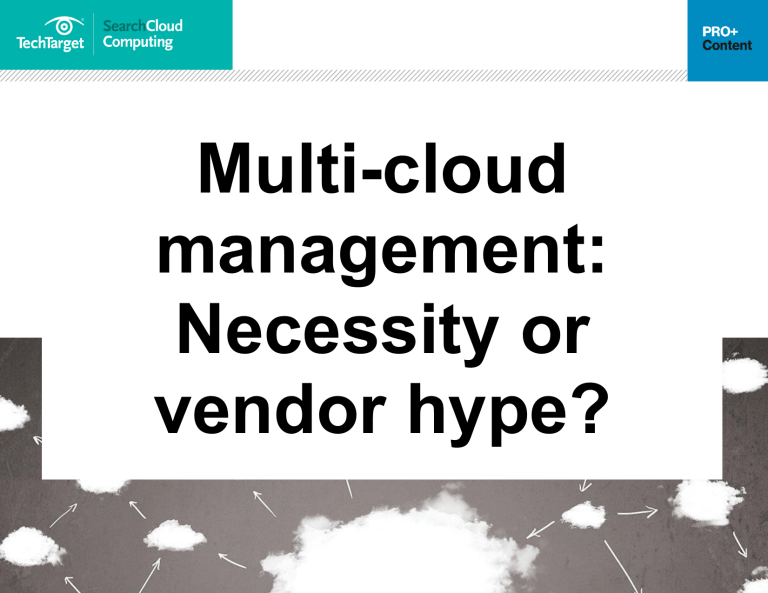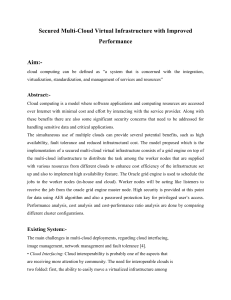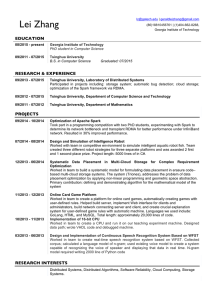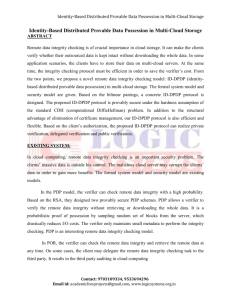
Multi-cloud management: Necessity or vendor hype? In this e-guide In this e-guide: Multi-cloud management still Your organization may be using multi-cloud computing to avoid vendor lock-in or for safer disaster recovery, but there is still a lot of debate around whether or not a multi-cloud management platform is worth the hype, or what it can really accomplish for you. a work in progress for IT teams User self-service challenges mount in multi-cloud Take a look at this guide to see a few differing opinions on the topic, and find what sort of multi-cloud management platform, if any, will work best for you. Read on to compare offerings from vendors such as TotalCloud, Microsoft, VMware, and many more. computing The best multi-cloud strategy is to just ignore the hype Single pane of glass for multi-cloud management still elusive Page 1 of 20 In this e-guide Multi-cloud management still a work in progress for IT teams User self-service challenges mount in multi-cloud computing The best multi-cloud strategy is to just ignore the hype Single pane of glass for Multi-cloud management still a work in progress for IT teams Kerry Doyle Organizations of all sizes rely on cloud services to support new initiatives, stay competitive and capture greater business value. Companies often depend on multiple clouds to meet constantly evolving business goals and to avoid single-vendor lock-in and dependencies. With a multi-cloud approach, a business uses a combination of public cloud services from different providers and selects the most appropriate environment for both infrastructure and applications. The appeal of public cloud is driven by its affordability, with a broad set of capabilities available on a pay-as-you-go basis with global coverage. Also, providers have steadily improved security and met regulatory requirements that previously prevented critical workload deployments. IT environments now regularly consist of on-premises infrastructure with an infrastructure as a service (IaaS) clone, a mix of several public, private and hybrid cloud deployments and a growing reliance on software as a service. multi-cloud management still elusive Organizations choose multi-cloud deployments for a range of reasons. For example, a cloned IaaS deployment ensures higher availability, more efficient failover, disaster recovery and reduced risk of crippling distributed denial-of-service attacks. Moreover, the growing data explosion increasingly requires unique approaches to handling different types of corporate information. By having more than one service and diversifying cloud deployments, businesses can more effectively match specific workload requirements to the most appropriate platform while at the same time gaining leverage for negotiating service-level agreements and contracts. However, they will also face new multi-cloud management challenges. Page 2 of 20 In this e-guide Multiple clouds increase complexity Multi-cloud management still Tight integration, smooth operation and consistency remain the ideal characteristics of multicloud deployments. However, managing multiple clouds generally translates to additional IT complexity. For example, controlling cloud sprawl can take up valuable IT time and resources that otherwise could be devoted to more critical operations. a work in progress for IT teams User self-service challenges mount in multi-cloud computing The best multi-cloud strategy is to just ignore the hype Single pane of glass for multi-cloud management still elusive Relieving IT management pressure is especially important for the growing reservoirs of data. A key challenge for IT leaders is to ensure that all corporate information in the cloud is wellmanaged and protected. IT staff often have to fulfill corporate governance requirements while still meeting strict international regulations. High levels of data awareness and management will be even more critical as the EU General Data Protection Regulation comes into play in 2018. Cloud sprawl will limit visibility, which also makes A key goal for most it difficult to prevent shadow IT. Unsecured cloud deployments create opportunities for data businesses is to ensure breaches and other serious vulnerabilities. These that all their diverse unauthorized deployments can also replicate cloud services function existing functionality or lead to data and resource duplication, which results in unnecessary uniformly. spending. Finally, lack of consistency in cloud APIs presents another IT headache in which code revisions are required to bridge incompatible APIs associated with individual cloud architectures. These limitations underscore the need for simplified operations, greater control and the increased automation that managed services and multi-cloud management platforms offer. Page 3 of 20 In this e-guide Multi-cloud management still a work in progress for IT teams User self-service challenges mount in multi-cloud computing The best multi-cloud strategy is to just ignore the hype Single pane of glass for multi-cloud management still elusive Multi-cloud management platforms are designed to help IT professionals unify disparate cloud environments. These platforms also enable teams to more easily execute workloads on the most compatible platform based on cost, reliability and advanced services. These are critical criteria. The faster an organization can deploy cloud resources to meet changing business goals, the more effectively it will maximize efficiency and contain costs. Pros, cons of multi-cloud management platforms A management platform provides organizations with new levels of order and visibility into multi-cloud environments and governance. A key goal for most businesses is to ensure that all their diverse cloud services function uniformly. As a flexible, customizable foundation, multi-cloud management platforms offer a self-service environment for requisitioning the most optimal cloud resources, from processing power to storage capabilities. Through increased visibility, IT professionals can more effectively track performance, resolve issues and accurately predict and control usage costs. While a multi-cloud management approach provides the necessary insight, automation and control to keep cloud sprawl in check, it represents an emerging market at an early stage of maturity. That means hurdles remain. For example, large branded platforms such as IBM Cloud Brokerage -- formerly cloudMatrix -- VMware vRealize and Microsoft Operations Management Suite prioritize the large service providers, often excluding niche providers. These brand-based multi-cloud management platforms will function more efficiently when paired with the technologies promoted by that provider. Additional hurdles include limited cloud API functionality. For example, not all cloud APIs offer full-service compatibility, which leaves an organization with only subsets of common features from each provider. In-house management and brokerage tools might also fail to update on a regular basis to accommodate new services at the speed at which they're introduced. Yet Page 4 of 20 In this e-guide Multi-cloud management still a work in progress for IT teams User self-service challenges mount in multi-cloud computing The best multi-cloud strategy is to just ignore the hype Single pane of glass for multi-cloud management still these major multi-cloud management platforms still offer valuable tools. VMware vRealize Automation, for instance, is a key component that provides built-in workflows and GUI controls to automate provisioning and configuration, application delivery and container management across multiple clouds. It enables IT teams to go beyond automating server builds, and it extends to firewall rules, storage and backup schedules. Alternatively, third-party tools exist to provide customized monitoring frameworks and add-in management functionalities that fill monitoring gaps not covered by cloud vendors. These cloud management platforms can handle specific tasks, from enabling cost transparency and ensuring compliance to increasing resiliency and reducing security risks. Nagios offers a unified cloud management console to monitor CPU cycles and performance, memory and disk consumption. It is designed to integrate with third-party software and offers compatibility with a slew of platforms. However, it is time-consuming to set up and can pose challenges to engineers unfamiliar with Linux or Unix commands. In contrast, SolarWinds Server & Application Monitor offers a comprehensive set of monitoring templates with easy configuration. The third-party tool OP5 is closely related to Nagios, though more streamlined. It makes it easy to add new nodes and servers via their web-based dashboard. As a competitive open source alternative, Zabbix offers a compact and lightweight profile that scales easily and offers compatibility with a range of OSes. elusive Page 5 of 20 In this e-guide Multi-cloud management still a work in progress for IT teams User self-service challenges mount in multi-cloud computing The best multi-cloud strategy is to just ignore the hype Single pane of glass for multi-cloud management still elusive It's useful to note that all of these multi-cloud management approaches, whether major branded platforms or third-party tools, present challenges. Of particular concern are their abilities to integrate private clouds, manage customized legacy applications or gain granular control of hybrid environments. Page 6 of 20 In this e-guide Multi-cloud management still a work in progress for IT teams User self-service challenges mount in multi-cloud computing The best multi-cloud Ultimately, when you consider the complexity of multi-cloud management, the areas of top concern for many organizations, regardless of the industry, are reining in costs and ensuring security. With either a comprehensive multi-cloud management platform or individual thirdparty tools, organizations can gain full awareness of cloud spending patterns and automatically scale up or down to achieve the right balance between cost and service availability. The same automated approach applies to security implementations, policy controls and governance. Select the right multi-cloud management tool to ensure that your business gains the most innovative, cost-effective services from multi-cloud deployments. ▼ strategy is to just ignore the hype Single pane of glass for multi-cloud management still elusive Page 7 of 20 Next Article In this e-guide Multi-cloud management still a work in progress for IT teams User self-service challenges mount in multi-cloud computing The best multi-cloud strategy is to just ignore the hype Single pane of glass for multi-cloud management still elusive User self-service challenges mount in multi-cloud computing Paul Korzeniowski, Freelance Writer User self-service is a big potential benefit of cloud computing. With it, deluged IT departments can offload mundane resource allocation tasks to users, affording themselves more time to work on strategic projects. But many organizations do not offer, or are wary of, this feature for a variety of reasons, and the growing use of multi-cloud computing could complicate things even more. A number of factors deter enterprises from a user self-service provisioning model. First, to get there, organizations must alter their development and deployment processes. Both the IT department and business units need to understand how to manage cloud services -- a change that often requires training and more dialogue between the two groups. Sprawl is also a concern. IT teams worry that business departments will spin up more workloads than they need. Historically, enterprises haven't had tools to control this kind of workload sprawl, but fortunately, vendors ranging from Cisco Systems to RightScale have developed tools that provide more cloud transparency and management features. The self-service integration challenge Despite these tools, challenges around user self-service persist, and the growth of multi-cloud computing amplifies those challenges. Page 8 of 20 In this e-guide Multi-cloud management still a work in progress for IT teams User self-service challenges mount in multi-cloud computing The best multi-cloud strategy is to just ignore the hype Single pane of glass for multi-cloud management still elusive Today, 63% of corporations use at least two cloud vendors, according to Lauren E. Nelson, principal analyst at Forrester Research. Many cloud services have also been designed to run autonomously with virtually no common integration points. This is because vendors focus more on improving their own capabilities than they do on integrating those capabilities with a competitor. Consequently, when a business uses multiple cloud platforms, IT teams might need to support multiple user self-service portals, and integrating them is difficult. "Each cloud vendor's portal formats data, presents information to users and supports development tools in a different way," said Jay Lyman, principal analyst at 451 Research. Each cloud vendor's portal formats data, presents information to users and supports development tools in a different way. Principal analyst, 451 A self-service portal, whether hosted by a cloud vendor or an enterprise, is an infrastructure Research software application. Unlike a word processing app, for example, a portal does nothing by itself; Jay Lyman you don't just buy it, download it and run it. Enterprises need to tie the portal into their existing application infrastructure, which is complex, given that those infrastructures often have thousands or tens of thousands of APIs. Basically, to deploy a self-service portal, a company needs to take on a massive amount of software integration work. Because of these challenges, integrating self-service portals for multi-cloud is at a nascent stage of development. Page 9 of 20 In this e-guide Multi-cloud management still a work in progress for IT teams User self-service challenges mount in multi-cloud computing The best multi-cloud strategy is to just ignore the hype Single pane of glass for multi-cloud management still elusive Vendors have signed a few joint development agreements, such as the one between Amazon Web Services and VMware, that could help with these efforts, but integration work remains. That scenario is not expected to change anytime soon. No standards group has shown interest in taking on the work, and while open source has helped spur the development of common interfaces, there hasn't been significant movement in this area yet. Looking ahead A few enterprises have developed some common dashboards, and there are some tools, such as RightScale, that can help with these multi-cloud self-service challenges. But, in many cases, cloud portals still largely run autonomously. And that user self-service work might stay on IT team's back burner for now. "Many businesses are taking a step back and trying to determine what level of integration they need with multi-cloud solutions," Nelson said. While integrated multi-cloud self-service offers some benefits for IT, other needs, such as multi-cloud cost containment, are now higher on the corporate wish list. Eventually, vendors and IT teams will put other building blocks in place to ease cloud selfservice integration. For instance, according to Larry Carvalho, research manager at IDC, a fully containerized development environment would break down barriers and ease integration. ▼ Next Article Page 10 of 20 In this e-guide Multi-cloud management still a work in progress for IT teams User self-service challenges mount in multi-cloud computing The best multi-cloud strategy is to just ignore the hype Single pane of glass for multi-cloud management still elusive The best multi-cloud strategy is to just ignore the hype Nick Martin, Executive Editor Like so many marketing terms before it, multi-cloud is the latest IT buzzword that means everything and nothing all at once. The rush to pin the multi-cloud label on everything and the dire warnings that you need a multi-cloud strategy only serve to confuse IT pros and obfuscate today's real, technical cloud challenges. Industry analysts and vendors are eager to claim that multi-cloud is not only the future -- it's here now. Yet ask them to define multi-cloud, and you're likely to get competing or even evasive answers. Many analyst firms, including IDC, help feed this confusion by defining multi-cloud broadly as the use of any cloud-based services, including SaaS. One vendor even inexplicably slapped the multi-cloud sticker on its existing hyper-converged infrastructure boxes. While it's true that today's businesses use a variety of cloud services, let's not roll back the clock to when the cloud was a mysterious concept. There's no reason to confuse SaaS with IaaS or imply that a single term with such a broad definition is useful. Under this definition, an organization with a dusty old server closet could qualify for the multi-cloud label if it used both Office 365 and Box. That organization would face vastly different challenges and provide a much different level of IT service than a company that allows developers to spin up new instances across multiple IaaS providers. Saying organizations need a multi-cloud strategy to help manage SaaS subscriptions is like saying organizations need a multi-software strategy. The SaaS delivery model actually simplifies or eliminates many technical challenges for developers and IT professionals. It does Page 11 of 20 In this e-guide Multi-cloud management still a work in progress for IT teams User self-service challenges mount in multi-cloud computing The best multi-cloud strategy is to just ignore the hype Single pane of glass for multi-cloud management still elusive present new administrative challenges and requires admins to look closer at user access, governance and billing. But these challenges aren't unique to a cloud delivery model. Used in this overly broad fashion, multi-cloud is nothing more than a checkbox for business leaders and a term serious IT professionals should ignore. Remember when everyone needed a private cloud? There's a problem with It seemed like only yesterday these same blindly adopting the vendors and analysts were touting the advantage multi-cloud vocabulary. of private clouds. C-level executives heard the hype and told their IT teams to build one without understanding that a true private cloud has a specific definition -- one that emphasizes self-service portals, automated provisioning and chargeback. As a result, many IT admins just adopted the lexicon and began calling their existing virtualized data centers "private clouds." The business-savvy among them used the opportunity to justify a new virtualization management tool purchase. I poked fun at this trend in 2013, joking that, "we won't tell if you need to start calling your infrastructure a private cloud to get your boss off your back." Today's equivalent would be using your company's Office 365 migration to justify a new IaaS cloud management tool in the name of multi-cloud strategy. You're welcome. Multi-cloud is a dangerous word There's a problem with blindly adopting the multi-cloud vocabulary. It was easy to gloss over the technical gap between vanilla virtualization and private cloud, and it didn't matter much to executives so long as your infrastructure met business needs. Multi-cloud is a more Page 12 of 20 In this e-guide Multi-cloud management still a work in progress for IT teams User self-service challenges mount in multi-cloud computing The best multi-cloud strategy is to just ignore the dangerous buzzword because organizations still face difficult technical challenges to managing IaaS clouds. Large-scale IaaS provider outages are rare, but how will you explain to the CEO that, while it's true Office 365 runs on Azure, your multi-cloud strategy doesn't include a contingency plan for an AWS EC2 outage? How will you articulate that egress fees make IaaS migrations painfully expensive after proclaiming to be a multi-cloud whiz? Broad definitions absent of technical discussion invite communication breakdowns that can hurt businesses and your career. What should a multi-cloud strategy look like? The challenges associated with managing multiple IaaS clouds continue to grow. If you thought keeping track of multiple SaaS bills was tough, try deciphering invoices from different IaaS providers. The problem with vendor lock-in also worsens as IaaS providers continue to expand their proprietary services and developer tools. Many IT admins are discovering they're locked in to multiple clouds as a result of pet projects, silos or shadow IT. hype Single pane of glass for multi-cloud management still elusive Unfortunately, many initiatives that aimed to set open standards and provide cross-cloud compatibility, such as OpenStack and Eucalyptus, have lost steam. But there's still room for hope. Amazon's reluctant acceptance of Kubernetes solidifies a common container orchestration platform across several IaaS providers. And many function-as-a-service platforms offer unbiased access to compute resources. Organizations don't just need multiple clouds or software delivered as a service. They need tools, standards or platforms that aim to abstract away the underlying infrastructure differences and allow multiple clouds to work like one. Whether we'll ever see wholesale commoditization of cloud infrastructure resources is an open question, but don't let today's multi-cloud hype distract from this goal. Next Article Page 13 of 20 In this e-guide Multi-cloud management still a work in progress for IT teams User self-service challenges mount in multi-cloud computing The best multi-cloud strategy is to just ignore the hype Single pane of glass for multi-cloud management still elusive Single pane of glass for multi-cloud management still elusive Alan Earls, Contributor Cloud computing may solve many problems associated with traditional on-premises infrastructure, but visibility and management remain a challenge. Third-party cloud products have been around almost since the inception of the public cloud to help address these issues. However, according to analysts, their most ambitious goals haven't always resonated with buyers. Now, new and established vendors are back with some fresh approaches to help organizations tackle complex multi-cloud management challenges. One example is TotalCloud, a new vendor that offers a 'gamified' interface to visualize and control AWS cloud resources. An immersive tool takes advantage of the natural capabilities of the human mind, which are oriented toward visual and aural information, said CEO and founder, Pradeep Kumar. TotalCloud delivers a Minecraft-like real-time user experience that uses "behavioral-AI concepts used in real-time strategy games such as Warcraft and StarCraft," Kumar said. Users get a viewable context of their cloud infrastructure and then maneuver the behavior of affected cloud resources, in the right context, using quick decision-making insights from one single immersive console. "The action could be for the purpose of optimization, fixing a security issue, checking on compliance, looking for cost-saving opportunities, performing cloud operations, or making a disaster recovery," Kumar said. And, he explained, this new approach is a step away from the Page 14 of 20 In this e-guide Multi-cloud management still traditional siloed approach of managing and optimizing resources, and toward the singlepane-of-glass goal. Single-pane management still out of reach a work in progress for IT teams User self-service challenges mount in multi-cloud computing The best multi-cloud strategy is to just ignore the That chimerical goal has been the focus of vendors for years, said Forrester analyst Lauren E. Nelson. "The vision set forth in 2010 was a single pane of glass, but it has been a waiting game," she said. The tools that tried to deliver on that vision may have been over-ambitious or not focused enough on actual problems, she said. As enterprise cloud use expanded, so too did the list of functions a single-pane-of-glass tool must offer -- including an interface layer to ensure portability across cloud vendors. Today, the market is more focused on day-to-day management, such as how to lower cloud bills, how to optimize use and how to mitigate performance problems. "Vendors are breaking into specific functionality in hopes of increasing engagement with the client and eventually selling more," Nelson said. hype Single pane of glass for multi-cloud management still elusive In short, "A lot of people realize they can't wait any longer for the single pane," she said, so spending now is mostly on single capabilities. The challenge with a single pane of glass is a loss of fidelity, said Owen Rogers, a research director at 451 Research. He compares the single-pane-of-glass goal to the ubiquitous universal remote control for home entertainment systems. "Having just one control for all your devices is a Page 15 of 20 The vision set forth in 2010 was a single pane of glass, but it has been a waiting game. Forrester analyst Lauren E. Nelson In this e-guide Multi-cloud management still a work in progress for IT teams User self-service challenges mount in multi-cloud computing The best multi-cloud strategy is to just ignore the hype Single pane of glass for multi-cloud management still elusive lot more convenient than multiple controls," he said. "But each device has its intricacies that can't be captured by a single control." As a result, you still have to keep your old remote controls for things such as channel tuning or configuration. In other words, the single remote can do the majority of things, but it'll never replace everything because that would make the single control too complex and reduce its advantage of simplicity. "The same issue lives with the single cloud pane of glass -- they can do the common things that all providers offer, but they're not so good at the differentiated features between providers," Rogers said. Cloud tools refocus on DevOps problems Torsten Volk, a managing research director at Enterprise Management Associates, said the real problem is that the vendors that tried to deliver sophisticated multi-cloud management "didn't pay attention to the DevOps guys who actually had the pain." Over time, DevOps teams came to rely on the management capabilities of cloud providers, which also offered the ability to deliver crucial cost information. Volk said he has seen other vendors, including Morpheus Data and YotaScale, try a new approach to address the frustrations of cloud management. In many cases, these vendors are not trying to build a better multi-cloud management tool; they are building a different mouse trap. "The key cloud DevOps problems are all related to compliance, security, cost, speed and quality," Volk said. Third-party vendors are looking to help solve these DevOps problems by adding robust automation. Page 16 of 20 In this e-guide Multi-cloud management still a work in progress for IT teams User self-service challenges mount in multi-cloud computing The best multi-cloud strategy is to just ignore the hype Single pane of glass for multi-cloud management still elusive YotaScale, which Volk said is "more like TotalCloud in its approach," harnesses AI to deliver cloud performance management. Several companies offer tools that play a role in making cloud more manageable, Nelson said. Cloudify offers an open source orchestration platform that aims to manage and automate lifecycle processes in the cloud. It is built on Topology and Orchestration Specification for Cloud Applications (TOSCA), which is a language based on OASIS. The RightScale Cloud Management platform provides organizations access to a portfolio of public, private and hybrid cloud services while maintaining enterprise control. The company's Optima product is a cloud cost management and optimization tool. Turbonomic focuses more on workload automation for hybrid cloud environments. New Relic and AppDynamics both focus on application monitoring and management. Other companies include the following: ParkMyCloud, a SaaS tool that enables users to automatically schedule on and off times for their idle cloud resources; FittedCloud, a platform to help match provisioning and utilization; GorillaStack, which helps parse AWS reports to support better utilization; Skeddly, which provides scheduled automation services for AWS; DivvyCloud, which automates optimization and compliance; Densify, which provides SaaS-based machine learning cloud optimization; OpsRamp, a cloud-based management hub; io, a cost-focused instance manager for AWS; Spotinst, a framework for provisioning and utilization management; and HashiCorp, which offers a range of tools to manage both physical and cloud-based VMs. Page 17 of 20 In this e-guide Multi-cloud management still a work in progress for IT teams User self-service challenges mount in multi-cloud computing The best multi-cloud strategy is to just ignore the hype Single pane of glass for multi-cloud management still elusive Page 18 of 20 In this e-guide Multi-cloud management still a work in progress for IT teams User self-service challenges mount in multi-cloud computing The best multi-cloud strategy is to just ignore the hype Single pane of glass for multi-cloud management still elusive But the independent vendors aren't alone, and cloud providers will continue to expand their management capabilities. "If AWS had fantastic monitoring and others [did], too, would that be enough?" Nelson said. "Will people pay for cross-cloud views or brokerage insights? So far, the answer is 'no.'" Furthermore, service players like Accenture and value-added cloud players like Rackspace also have a role, she said, because they are building strong management capabilities into their own offerings. Sometimes those capabilities come with an extra charge. "Again, the question is: 'If these things are included in the service price, would you really pay for a separate tool?'" she said. Multi-cloud management will remain a challenge Regardless of who attacks the problem, there is much yet to be done in the realm of cloud management, said Dan Conde, a senior analyst at Enterprise Strategy Group. "Many people will choose a single cloud vendor for its particular strengths," he said. But, regardless of how much management functionality individual cloud providers offer, "multicloud will be a problem." Primary cloud management challenges include provisioning, configuring after initial provisioning, monitoring for cost and performance and security. "Doing things to be crosscloud may force you to be looking at or using the lowest common denominator; that would be bad if you can't use each cloud's special capabilities," Conde said. And that points to another challenge that goes beyond simply ensuring smooth operations. "I think the next big area is cloud optimization, automatically ensuring that users are paying the lowest price for their resources while meeting requirements," Rogers said. These can be categorized into two types: waste managers that continually tidy-up unused resources and Page 19 of 20 In this e-guide Multi-cloud management still a work in progress for IT teams User self-service challenges mount in multi-cloud computing The best multi-cloud strategy is to just ignore the broker-dealers that balance workloads across different pricing models to achieve the lowest cost. And what of the elusive single pane of glass? "It is an interesting approach if you can get people to adopt it," Volk said. ▼ Next Article Multi-cloud management still a work in progress for IT teams User self-service challenges mount in multi-cloud computing The best multi-cloud strategy is to just ignore the hype Single pane of glass for multi-cloud management still elusive hype Single pane of glass for multi-cloud management still elusive Page 20 of 20




